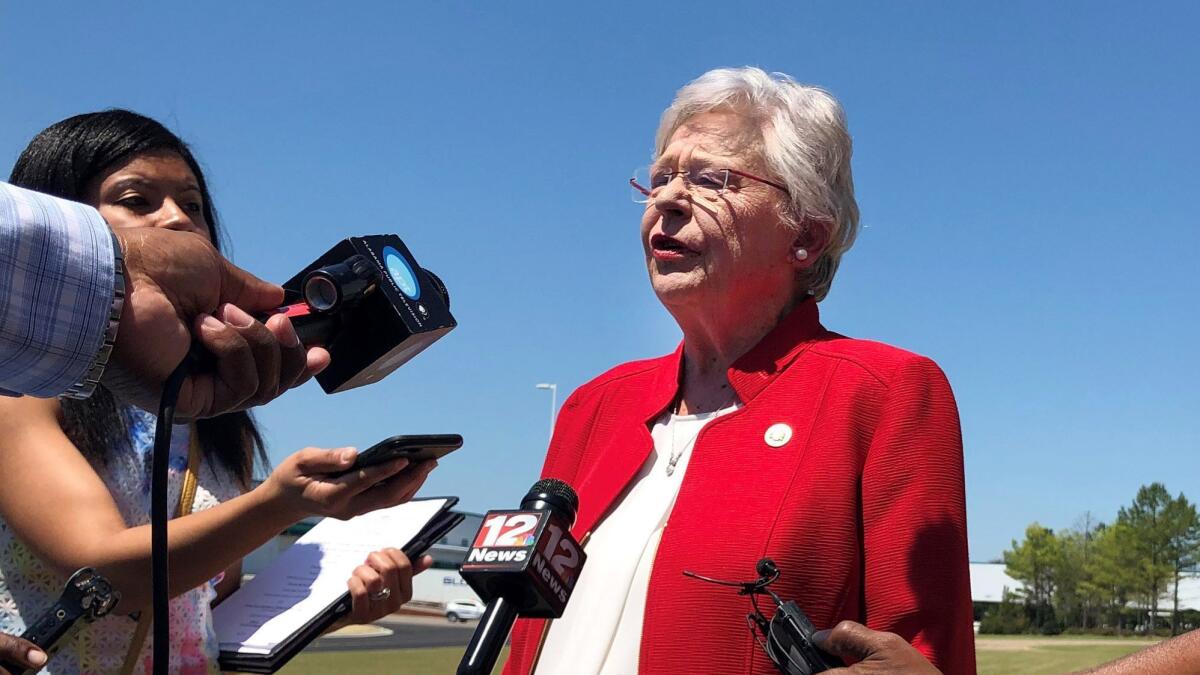Column: States with the worst anti-abortion laws also have the worst infant mortality rates

This shouldn’t come as a surprise, since it’s a relationship that’s been known for years, but the states with the harshest restrictions on abortions also have the worst infant mortality rates.
The correspondence is unmistakable, and not hard to explain: Those states’ governments also show the least concern for maternal and infant health in general, as represented by public policies.
Advocates of women’s healthcare rights moved promptly to issue reminders of the connection Tuesday, after the Republican-dominated Alabama Legislature passed the most draconian anti-abortion bill in the nation. Republican Gov. Kay Ivey signed the measure Wednesday.
In a state that has some of the worst health outcomes for women in the nation...Alabama is putting women’s lives at an even greater risk.
— Leana Wen, Planned Parenthood Action Fund
Alabama is one of two states, with Georgia, that enacted new abortion restrictions over the last week. Their records on maternal and infant health are shameful. Alabama is tied for fourth-worst place in infant mortality, with a rate of 7.4 deaths per 1,000 live births. Georgia, with a rate of 7.2, is tied for seventh-worst.
“In a state that has some of the worst health outcomes for women in the nation—such as the highest rate of cervical cancer -- Alabama is putting women’s lives at an even greater risk,” said Leana Wen, president of the Planned Parenthood Action Fund.
Of the 12 states ranked highest in infant mortality rates, all with rates of 7.0 or higher, 11 are described by the abortion rights organization NARAL as imposing “severely restricted access” on abortions. The one exception, West Virginia, is listed as having “restricted access,” a notch better. But NARAL reports that 90% of women in the state live in counties without a single abortion clinic.
By contrast, of the four states with the best infant mortality rates, all at 4.2 or better—California and Washington offer “strongly protected access,” NARAL says, and New Hampshire and Massachusetts “some access.” But access to abortion clinics in all four is strong—only 5% of women in California live in a county without a single clinic, followed by 14% in Massachusetts, 15% in Washington and 30% in New Hampshire.
These statistics should give the lie to legislators’ arguments that their anti-abortion measures are somehow good for women’s health or aimed at protecting their rights. A 2017 study by the Center for Reproductive Rights and Ibis Reproductive Health, a healthcare think tank, found that hostility to reproductive rights tended to go hand-in-hand with a lack of state-level policies supporting women’s and infant health.
States with the largest number of abortion restrictions such as mandatory waiting periods, counseling and ultrasounds; restrictions on insurance coverage for abortions in public or private health plans; and unnecessary standards on ambulatory abortion clinics tended to have the fewest number of supportive policies, the survey found. Those included Medicaid expansion under the Affordable Care Act; family leave; sex- and HIV education programs; and good access to children’s health insurance programs.
Indiana, Kansas, Oklahoma, Mississippi and South Carolina all topped out with 14 of the 14 abortion restrictions tracked by the researchers; all also offered 11 or fewer of the 24 supportive policies identified by the researchers.
To take just one of those policies, seven of the 12 states with highest infant mortality have refused to expand Medicaid. Of the others, Indiana and Louisiana approved their expansion late (after Jan. 1, 2014, the earliest date for expansion) and three, including Ohio, have implemented it with restrictions such as work requirements or premiums.
Experts have connected the dots between abortion restrictions and maternal and infant health problems. Limits on access to legal abortions can prompt women to choose unsafe alternatives. Indeed, the reported rate of maternal deaths in Texas soared from 72 deaths per 100,000 live births in 2010 to 148 deaths per 100,000 live births in 2012, a trend that some experts attributed to the state’s closing of abortion clinics and cuts in funding for Planned Parenthood and other family planning services during the same period.
Unintended pregnancies, moreover, tend to be associated with poor health for women and their children, an unsurprising development among households with unwanted children.
The restrictions also have economic and racial components, for low-income and minority women face difficulties in accessing healthcare even under ideal conditions. The restrictions tend to fall heaviest on them.
These findings add a disturbing perspective to the measures in Georgia and Alabama. Both have elements of unexampled cruelty and malevolence toward women by criminalizing their choices in family planning. Alabama’s measure is so restrictive it effectively bans all abortions. The health profiles of women and children in those states, already among the most dismal in the nation, are about to get worse.
Keep up to date with Michael Hiltzik. Follow @hiltzikm on Twitter, see his Facebook page, or email [email protected].
Return to Michael Hiltzik’s blog.
More to Read
Inside the business of entertainment
The Wide Shot brings you news, analysis and insights on everything from streaming wars to production — and what it all means for the future.
You may occasionally receive promotional content from the Los Angeles Times.











